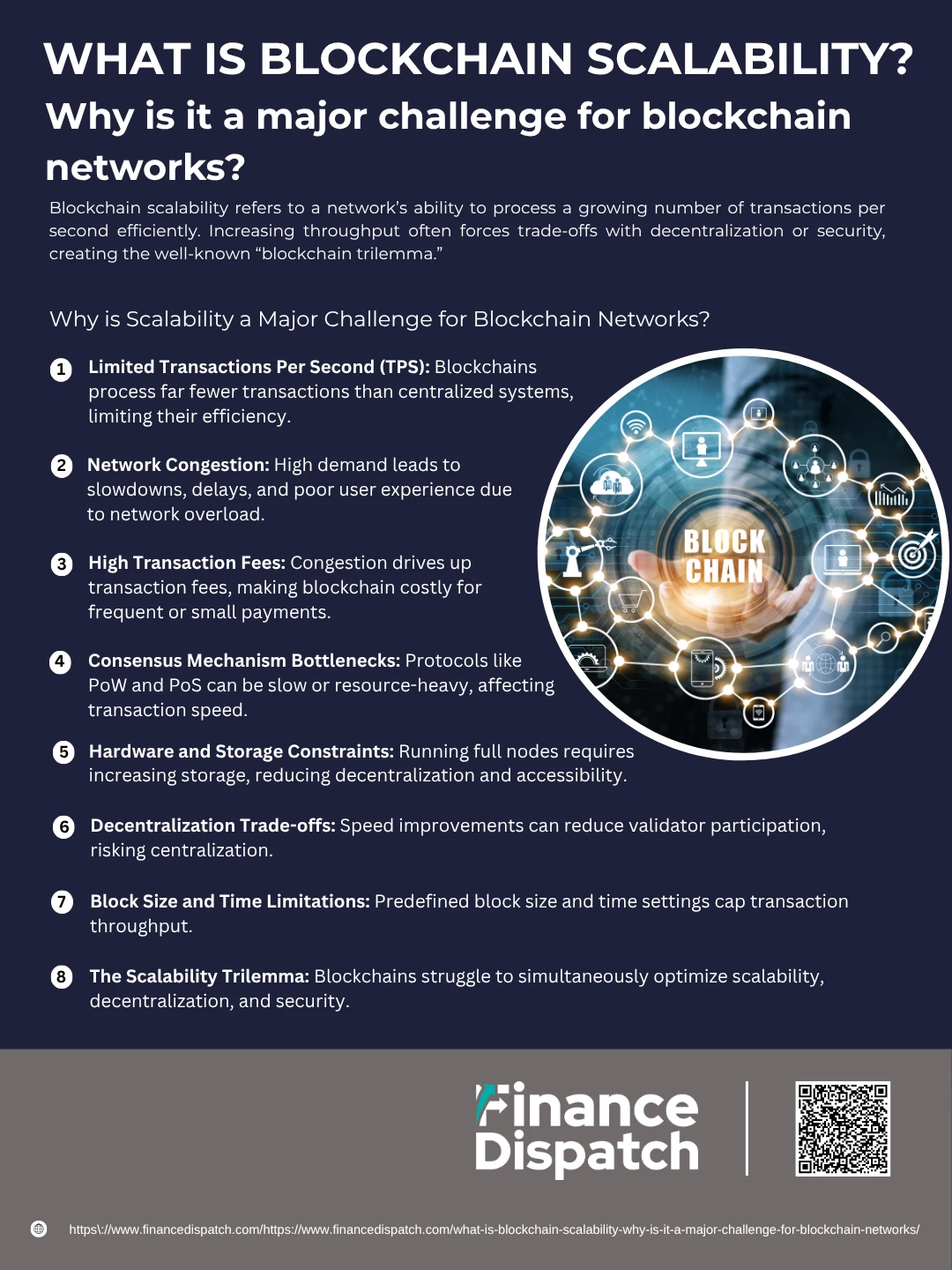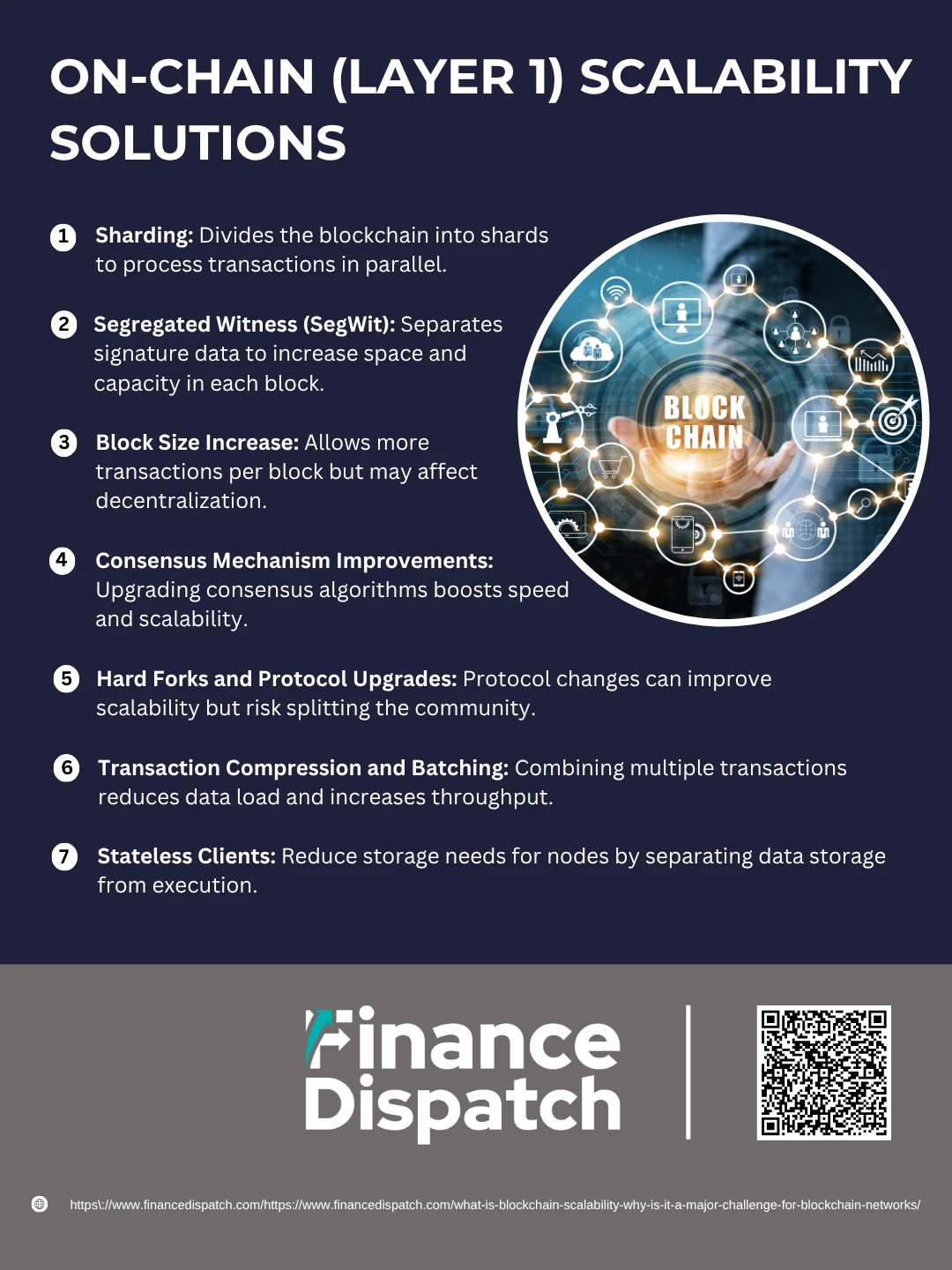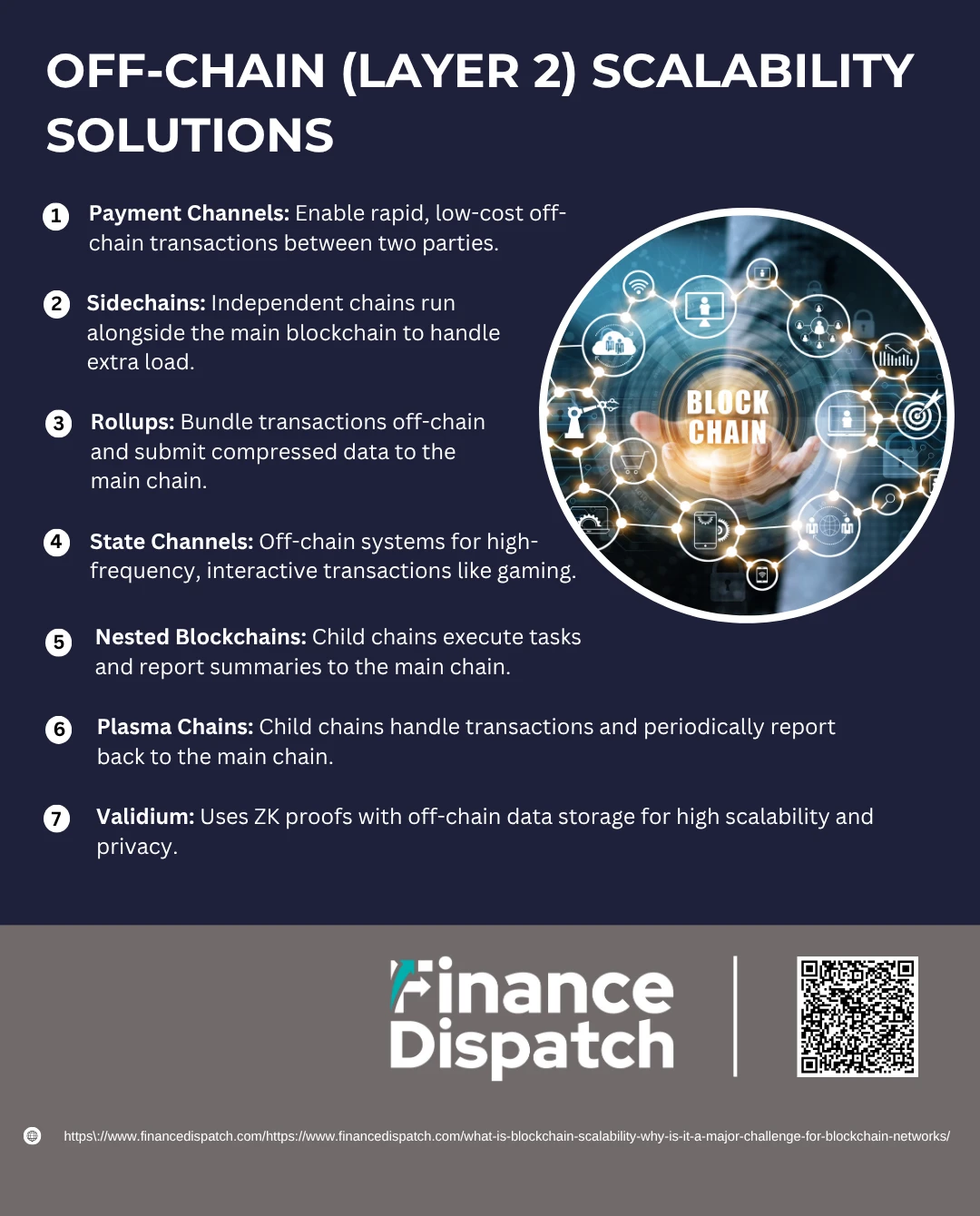Blockchain scalability refers to a network’s ability to process an increasing number of transactions and user demands without compromising performance, speed, or security. As blockchain technology continues to expand beyond cryptocurrencies into sectors like finance, healthcare, and supply chains, its capacity to scale efficiently has become one of its most pressing concerns. Popular networks such as Bitcoin and Ethereum face bottlenecks, often managing only a handful of transactions per second compared to thousands by traditional systems like Visa. These limitations hinder user experience and broader adoption. This article explores what blockchain scalability truly means and why it remains a complex challenge for developers and the future of decentralized systems.
What is Blockchain Scalability?
Blockchain scalability is the ability of a blockchain network to handle a growing amount of transactions, data, and participants without slowing down or increasing costs. In practical terms, it refers to how efficiently a blockchain can process more transactions per second (TPS) as demand increases. A scalable blockchain maintains its speed, security, and decentralization even as more users join and activity rises. However, unlike centralized systems, every node in a blockchain must validate and store all transactions, which creates performance bottlenecks. Achieving true scalability means improving transaction throughput and network efficiency while preserving the core principles of blockchain technology.
 Why is Scalability a Major Challenge for Blockchain Networks?
Why is Scalability a Major Challenge for Blockchain Networks?
Scalability has emerged as one of the biggest obstacles preventing blockchain from reaching its full potential. While the technology is celebrated for its decentralization, transparency, and security, these very strengths introduce trade-offs that hinder performance under high demand. As more users and applications join the network, blockchain systems often become slower, more expensive, and less efficient—making them impractical for widespread, real-time use. The root of this problem lies in how blockchain achieves consensus and maintains decentralization, which inherently limits the number of transactions it can process per second. This bottleneck creates a pressing challenge: how to expand capacity without sacrificing the core values that make blockchain revolutionary.
Here are the major reasons why scalability remains a persistent challenge for blockchain networks:
1. Limited Transactions Per Second (TPS)
Blockchains like Bitcoin and Ethereum process far fewer transactions per second compared to centralized systems. Bitcoin averages about 7 TPS and Ethereum around 15–30 TPS, while traditional payment networks like Visa handle over 1,700 TPS. This vast difference makes blockchains unsuitable for mass-market, high-speed applications.
2. Network Congestion
During periods of high demand, such as popular NFT launches or DeFi activity, blockchain networks become congested. This results in long delays, transaction backlogs, and a poor user experience as the network struggles to validate every request.
3. High Transaction Fees
When demand exceeds network capacity, users often offer higher fees to prioritize their transactions. This bidding war can make blockchain prohibitively expensive, especially for small-value or frequent transactions like micro-payments or in-game items.
4. Consensus Mechanism Bottlenecks
Most blockchains use consensus protocols like Proof-of-Work (PoW) or Proof-of-Stake (PoS) to validate transactions. These mechanisms, while secure, can be slow or resource-intensive. PoW, in particular, introduces delays due to the time it takes to solve complex cryptographic puzzles.
5. Hardware and Storage Constraints
Every full node in a blockchain must store a complete copy of the ledger, which grows with each transaction. As blockchains expand, it becomes increasingly difficult for average users to run nodes, reducing decentralization and raising technical barriers to entry.
6. Decentralization Trade-offs
Efforts to speed up blockchains—like increasing block sizes or reducing block times—can result in fewer participants being able to validate transactions, leading to centralization. This undermines the very principle of blockchain’s open and trustless nature.
7. Block Size and Time Limitations
Each blockchain has predefined block size and block generation time limits. While these controls ensure stability and security, they also cap the number of transactions processed at any given time, creating delays as usage scales up.
8. The Scalability Trilemma
Introduced by Ethereum co-founder Vitalik Buterin, the scalability trilemma states that blockchains can optimize for only two out of three properties: scalability, security, and decentralization. Improving one often means weakening another, making it difficult to scale without compromise.
The Blockchain Scalability Trilemma
At the heart of blockchain’s scalability challenge lies a concept known as the Blockchain Scalability Trilemma, introduced by Ethereum co-founder Vitalik Buterin. It asserts that a blockchain system can only fully optimize two out of the following three core properties at any given time: Decentralization, Security, and Scalability. Improving one often requires compromising on at least one of the others. This trade-off presents a fundamental dilemma for blockchain developers who aim to build fast, secure, and decentralized systems. Below is a table that illustrates how focusing on any two pillars typically impacts the third.
| Optimized Properties | Sacrificed Property | Explanation |
| Decentralization + Security | Scalability | The network is open and secure, but processing is slow and limited (e.g., Bitcoin and Ethereum in their early versions). |
| Security + Scalability | Decentralization | The system may rely on fewer, more powerful nodes to increase speed and throughput, reducing openness (e.g., EOS, which has only 21 validators). |
| Scalability + Decentralization | Security | Optimizing speed and decentralization can introduce vulnerabilities, as weaker consensus models may lead to easier manipulation or attacks. |
Factors Affecting Blockchain Scalability
Blockchain scalability is influenced by a variety of technical and structural components that determine how well a network can handle increasing transaction volume and user demand. These factors are not isolated—they interact and compound each other, making it more challenging to scale without sacrificing security or decentralization. Understanding these key factors is essential to designing efficient, high-performing blockchain systems.
Here are the major factors that affect blockchain scalability:
1. Block Size
The maximum amount of data that a block can contain directly limits how many transactions can be processed at once. Larger blocks can hold more transactions but require more storage and bandwidth, potentially centralizing the network.
2. Block Time
This refers to how frequently new blocks are created. Faster block times can improve throughput but may lead to more frequent forks and lower network stability.
3. Consensus Mechanism
Mechanisms like Proof of Work (PoW) and Proof of Stake (PoS) impact the speed and resource intensity of transaction validation. Some consensus protocols prioritize security over speed, slowing down scalability.
4. Transaction Finality
This is the time it takes for a transaction to become irreversible. Networks with longer finality times may experience delays, affecting usability and performance under load.
5. Network Bandwidth and Propagation Delay
Every new block must be broadcasted across the network. Limited bandwidth and high latency can slow down synchronization and reduce scalability.
6. Node Requirements and Hardware Constraints
As blockchains grow in size, nodes require more storage and processing power. This increases barriers to entry and may reduce decentralization, which in turn affects scalability.
7. State Size and Storage Overhead
A growing blockchain state (account balances, smart contracts, etc.) increases memory and storage demands on nodes, slowing down the system and making it harder to scale.
8. Smart Contract Complexity
Blockchains that support smart contracts, like Ethereum, must allocate resources for executing code, not just processing payments. Complex contracts can consume more gas and slow the network.
9. Transaction Throughput (TPS)
The number of transactions a network can process per second is the most direct measure of scalability. Higher TPS is desirable but hard to achieve without trade-offs.
 On-Chain (Layer 1) Scalability Solutions
On-Chain (Layer 1) Scalability Solutions
On-chain, or Layer 1, scalability solutions involve making changes directly to the core blockchain protocol to enhance its performance and transaction capacity. These improvements are designed to optimize how blocks are created, validated, and added to the ledger—without relying on external networks or layers. Unlike off-chain methods that offload transactions, Layer 1 solutions aim to increase the base layer’s efficiency, making it inherently more scalable while still maintaining decentralization and security. Below are some of the most prominent Layer 1 scalability techniques used or proposed in various blockchain ecosystems:
1. Sharding
Sharding divides the blockchain into smaller, independent segments called “shards.” Each shard processes its own subset of transactions and smart contracts, allowing multiple operations to occur simultaneously across the network. This parallel processing greatly increases throughput and reduces congestion.
2. Segregated Witness (SegWit)
SegWit is a protocol upgrade that separates signature data (witness) from transaction data, freeing up space within each block. This allows more transactions to be included in a single block, effectively increasing capacity without raising the block size limit.
3. Block Size Increase
By increasing the maximum block size, more transactions can be included per block. Bitcoin Cash is an example of a blockchain that implemented this change to improve transaction throughput. However, larger blocks may demand more resources, which can affect decentralization.
4. Consensus Mechanism Improvements
Enhancing or replacing consensus algorithms—such as switching from Proof of Work (PoW) to Proof of Stake (PoS)—can significantly improve scalability. PoS consumes fewer resources and processes transactions faster, making it a more scalable alternative.
5. Hard Forks and Protocol Upgrades
Some networks opt for hard forks to implement scalability-focused changes, such as increasing block size or adjusting block intervals. These upgrades allow for major enhancements but can cause chain splits and community division.
6. Transaction Compression and Batching
Techniques like batching multiple payments into one transaction help reduce data load on the blockchain. This allows more efficient use of space within each block and boosts transactions per second.
7. Stateless Clients
Stateless blockchain clients reduce the amount of data nodes must store by decoupling storage from execution. This lowers hardware requirements and speeds up processing, potentially making it easier for more users to participate in the network.
 Off-Chain (Layer 2) Scalability Solutions
Off-Chain (Layer 2) Scalability Solutions
Off-chain, or Layer 2, scalability solutions are designed to increase a blockchain network’s transaction capacity without altering the underlying Layer 1 protocol. These solutions operate on top of the main blockchain and process transactions externally, reducing the workload on the core network. Once the transactions are completed off-chain, only the final outcome is recorded on the main blockchain. This approach not only enhances speed and efficiency but also helps maintain decentralization and security. Below are the most widely used and promising Layer 2 scalability techniques:
1. Payment Channels
Payment channels allow two parties to conduct multiple transactions off-chain. Only the opening and closing transactions are recorded on-chain, while intermediate steps remain private and instant. Examples include the Lightning Network (Bitcoin) and Raiden Network (Ethereum).
2. Sidechains
Sidechains are independent blockchains that run parallel to the main chain and can interact with it via two-way pegs. They help offload transactions and applications, improving scalability without impacting the mainchain’s performance. Plasma and Polkadot’s parachains are well-known implementations.
3. Rollups
Rollups bundle multiple transactions into a single batch and submit it to the main chain. They come in two forms:
- Optimistic Rollups assume transactions are valid unless challenged.
- Zero-Knowledge (ZK) Rollups use cryptographic proofs to validate transactions.
Both methods significantly reduce on-chain data and gas fees while preserving security.
4. State Channels
Similar to payment channels, state channels allow participants to exchange not just funds, but also application states off-chain. They are especially useful for high-frequency interactions like gaming, betting, or trading platforms.
5. Nested Blockchains
These are blockchains built on top of the main chain, where the mainchain sets the rules, and sub-chains handle processing. Computation is executed on the child chains, and only the summary is recorded on the parent chain, reducing congestion.
6. Plasma Chains
Plasma is a Layer 2 framework for building scalable applications. It creates child chains anchored to the main blockchain, which handle transaction processing and periodically report to the main chain. This limits the data burden on the Layer 1 network.
7. Validium
Similar to ZK-Rollups, Validium uses zero-knowledge proofs but stores data off-chain instead of on-chain. This offers high scalability and privacy but relies more on trusted data availability layers.
Case Studies of Scalable Blockchain Implementations
As blockchain networks evolve, several projects have introduced real-world implementations aimed at solving the scalability dilemma without compromising decentralization or security. These case studies highlight how different blockchains have adopted unique strategies—such as Layer 1 enhancements, Layer 2 protocols, or novel consensus mechanisms—to handle higher transaction volumes efficiently. By examining these examples, we gain insights into what works, what trade-offs are involved, and how scalability can support mainstream adoption.
Here are some notable case studies of scalable blockchain implementations:
1. Ethereum 2.0
Ethereum transitioned from Proof of Work to Proof of Stake and plans to implement sharding to increase transaction throughput and reduce energy consumption. These upgrades aim to support thousands of transactions per second while maintaining decentralization.
2. Bitcoin Lightning Network
A Layer 2 solution for Bitcoin, the Lightning Network enables instant, low-fee transactions by creating off-chain payment channels. It’s particularly effective for microtransactions and helps reduce congestion on the main Bitcoin chain.
3. Solana
Known for its high throughput, Solana uses a unique Proof of History (PoH) mechanism combined with Proof of Stake to achieve up to 65,000 TPS. It sacrifices some decentralization for speed and scalability, making it suitable for DeFi and NFT platforms.
4. Polygon (formerly Matic Network)
Built as a Layer 2 scaling solution for Ethereum, Polygon uses sidechains and rollups to offer fast, low-cost transactions. It supports Ethereum-compatible dApps while reducing the burden on Ethereum’s mainnet.
5. Avalanche
Avalanche introduces a consensus protocol that enables near-instant finality and high scalability. It supports the creation of customized blockchains called subnets, which operate independently while benefiting from shared security.
6. Polkadot
Polkadot uses a relay chain and parachains to allow multiple blockchains to operate in parallel. Each parachain can be optimized for specific use cases, increasing the overall scalability and flexibility of the ecosystem.
7. Algorand
This blockchain uses a Pure Proof of Stake (PPoS) consensus mechanism, enabling quick block finality and high transaction speeds with low energy consumption—making it both scalable and environmentally friendly.
Benefits of Blockchain Scalability
Scalability is a crucial factor in determining the long-term success and real-world applicability of blockchain technology. A scalable blockchain can efficiently support a growing number of users, transactions, and applications without compromising performance, cost, or security. By improving scalability, blockchain networks become more practical for everyday use, fostering innovation across industries and enabling broader adoption.
Here are the key benefits of blockchain scalability:
1. Higher Transaction Throughput
Scalable blockchains can handle more transactions per second (TPS), ensuring smooth performance even during peak demand. This makes them suitable for high-volume use cases like finance, gaming, and supply chain tracking.
2. Lower Transaction Costs
By reducing network congestion, scalability decreases the competition for block space, leading to lower fees. This affordability benefits users and opens the door for microtransactions.
3. Faster Transaction Confirmation
Improved scalability results in quicker confirmation times, enhancing user experience and enabling real-time applications such as point-of-sale systems or rapid asset transfers.
4. Enhanced User Experience
With reduced delays and costs, users can interact with decentralized applications (dApps) more efficiently, encouraging more consistent and widespread engagement.
5. Support for Complex Applications
Scalable networks can handle advanced functionalities like smart contracts, token exchanges, and high-frequency trades without lag or failure, allowing developers to build richer, more powerful platforms.
6. Mainstream Adoption
Better performance and user-friendliness help blockchain move beyond niche communities and into mainstream sectors such as banking, healthcare, government, and retail.
7. Global Financial Inclusion
Scalable blockchains can offer fast, affordable services to underbanked populations worldwide, making cross-border payments and digital identity solutions more accessible.
8. Compatibility with Emerging Technologies
Scalability enables smooth integration with technologies like the Internet of Things (IoT), AI, and big data, supporting real-time automation and analytics across interconnected systems.
Challenges and Trade-Offs in Scaling Blockchain
Scaling blockchain technology is not a straightforward process—it involves navigating a complex landscape of technical limitations and philosophical trade-offs. One of the most well-known issues is the scalability trilemma, which asserts that it’s extremely difficult for a blockchain to simultaneously optimize for decentralization, security, and scalability. For example, increasing block size may improve transaction throughput but can lead to centralization by making it harder for individuals to run full nodes. Similarly, adopting faster consensus mechanisms might reduce latency but may weaken security or trust assumptions. Layer 2 solutions can improve efficiency, but they often add complexity and rely on off-chain components that may not be as decentralized. Every improvement aimed at enhancing scalability must be carefully balanced against its potential impact on network integrity, openness, and user accessibility. As a result, scaling blockchain remains a delicate exercise in compromise, demanding innovative solutions that maintain the technology’s foundational values while pushing the boundaries of performance.
Future Directions in Blockchain Scalability
The future of blockchain scalability lies in combining multiple innovative strategies to overcome current limitations while preserving decentralization and security. Layer 1 advancements like sharding and stateless clients aim to restructure blockchain architecture for higher efficiency at the protocol level. Meanwhile, Layer 2 technologies—such as rollups, payment channels, and sidechains—continue to mature, offering practical ways to offload transaction volume and reduce congestion. Emerging concepts like Layer 3 (application-specific scaling), cross-chain interoperability protocols (e.g., Chainlink CCIP), and quantum-resistant algorithms promise to further expand blockchain’s capacity and resilience. Additionally, the shift from energy-intensive consensus mechanisms like Proof of Work to more scalable alternatives like Proof of Stake and Delegated Proof of Stake is expected to accelerate. As blockchain ecosystems evolve, hybrid models that integrate on-chain and off-chain approaches will likely dominate, delivering both performance and trust. These advancements signal a promising path toward scalable, secure, and inclusive blockchain networks ready for global adoption.
Conclusion
Blockchain scalability is more than a technical challenge—it’s a pivotal factor that determines the technology’s viability for global, real-world adoption. While the promise of decentralized, secure systems is compelling, without the ability to efficiently handle growing user demand, blockchains risk falling short of their potential. Through a combination of on-chain and off-chain solutions, enhanced consensus mechanisms, and cross-chain innovations, the industry is making meaningful progress. However, every scalability improvement involves trade-offs that must be carefully balanced against decentralization and security. As research and development continue, the future of blockchain depends on finding scalable architectures that can support a wide range of applications—from microtransactions to enterprise-grade solutions—without compromising the foundational principles that make blockchain revolutionary.



